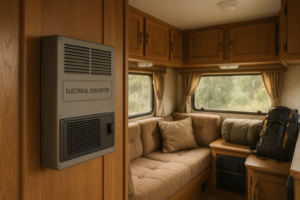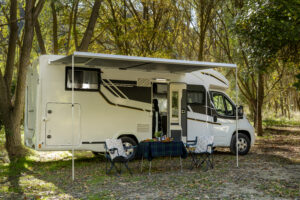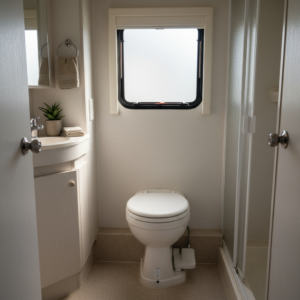
Which RV Roof Do You Have – Maintenance Tips for Each Type
Table of Contents
Why Knowing Your RV Roof Matters
Picture pulling into your campsite after a six-hour drive, only to step inside and discover a damp ceiling panel dripping onto your pillows. It’s an unfortunate – and often avoidable – surprise for many RV owners. Your roof is your rig’s first (and sometimes only) defense against downpours, hail, and scorching sun. If it’s not looked after, problems can sneak up fast. That’s why staying ahead of issues—and calling in RV roof repair pros when things get serious—can save you from a world of trouble.
But here’s the thing: not all RV roofs are built the same. Rubber, fiberglass, aluminum, and PVC all have different “care codes.” Knowing what’s overhead helps you prevent leaks, extend your roof’s lifespan, and keep your money going toward adventures—not repairs.
Common Types of RV Roofs and Their Basic Care
There is no one material used for RV roofs. Manufacturers choose different materials based on the RV’s design, weight, and the lifestyle each camper is designed for. Here are the most common RV roof material types:
EPDM Rubber Roof
EPDM is a black-or-white rubber membrane used on many travel trailers and Class C motorhomes. With the right maintenance, this roof can last ten years or more before oxidation sets in.
TPO Rubber Roof
TPO is the bright-white sheet commonly used on many newer Class A coaches. It’s lighter than EPDM and resists chalking. When kept clean and regularly resealed, a TPO roof typically lasts 10 to 15 years.
Fiberglass Roof
Fiberglass roofs are rigid panels finished with a gel coat. These are common on lightweight campers and some high-end motorhomes. With proper care, a fiberglass RV roof can remain watertight for 15 years or longer.
Aluminum Roof
Aluminum panels or riveted sheets are common on vintage trailers and certain toy haulers. These roofs handle heat well but need regular seam sealing and corrosion checks. A well-maintained aluminum roof can last more than 20 years.
PVC Roof
Some higher-end fifth wheels use bright-white PVC membranes with welded seams. This material resists mold and sheds dirt easily. With regular upkeep, a PVC roof can remain in good condition for up to 20 years.
RV Roof Maintenance Tips for Different Types of Camper Roofs
Here’s a simple breakdown of RV roof maintenance tips to help extend the life of your roof and keep your travels stress-free!
EPDM Rubber – Keep the Classic Going
The most important RV roof maintenance tip for EPDM roofs is gentle, consistent cleaning. Minimum twice a year or once every season:
- Rinse and Soap: Hose off loose debris, then scrub with a rubber-safe, non-petroleum cleaner and a soft brush.
- Inspect Seams: Look for chalky residue or hairline gaps; reseal with self-leveling lap sealant if needed.
- UV Shield: Apply a rubber-roof protectant after each wash to help prevent oxidation.
Avoid harsh solvents, and never use a pressure washer closer than a foot from the surface. EPDM roofs respond best to gentle care, not force.
TPO Rubber – Bright but Sensitive
TPO’s smooth surface repels dirt, but it still needs regular attention:
- Quarterly Wash: Clean with mild RV soap; campfire soot and tree sap can stain if left too long.
- Annual Seam Check: Although TPO seams are heat-bonded, edge tape and caulking around fixtures can dry out. Inspect and reseal them before summer.
Cool-Roof Bonus: Quick hand waxing enhances UV reflection and helps regulate interior temperatures, lowering energy bills and improving comfort.
Fiberglass – Wax On, Water Off
Fiberglass is durable, but long-term sun exposure can cause damage.
- Monthly Rinse: Remove dust and pollen, which can wear down the gel coat over time.
- Biannual Polish and Wax: Use a light polish to remove oxidation and a UV-blocking wax to seal pores and restore shine.
Spot-Fix Cracks: If you spot a hairline fracture, clean, dry, and seal it with marine-grade epoxy to prevent moisture intrusion.
Aluminum – Vintage Armor Needs Sealant
Aluminum roofs can last for decades with proper upkeep. Focus on seal integrity and corrosion prevention.
- Debris Sweep: After every trip, sweep off twigs and leaves that trap moisture around rivets.
- Corrosion Patrol: White powder near screws indicates electrolysis. Scrub with an aluminum-safe cleaner and apply protective wax.
Sealant Refresh: Once a year, replace old butyl tape under trim and reapply Dicor lap sealant over seams and rivets.
PVC – Low-Maintenance, Not No-Maintenance
PVC roofs are known for welded seams and a non-porous skin for easy cleaning, but they still benefit from regular checks.
- Gentle Detergent Rinse (Twice a Year): Use non-petroleum RV soap to clean the surface.
- UV Protectant Spray: Apply a quick coat each spring to maintain the bright-white finish and prevent chalking.
- Edge Flashing Check: Welded seams rarely fail, yet edge flashing can lift in high winds. Press down and re-bond with the PVC primer if you spot a gap.
Bottom line: Mastering the right care routines for your roof material helps you avoid leaks, reduce long-term repair costs, and enjoy worry-free miles ahead. Follow the playbook that matches your rooftop, and your RV stays road-ready and protected year after year.
Essential Overall RV Roof Maintenance Tips
No matter your camper roof type, following these general RV roof maintenance tips can help keep your rig dry and damage-free for years.
- Quarterly Walk-Around – Look for punctures, soft spots, or pooling water, especially after a storm or long trips. A quick scrub down with a soft brush, water, and the recommended cleaner will help spot these issues quickly.
- Biannual Deep Clean – Schedule a full-roof cleaning in spring and fall to remove grime, mold, or mildew buildup.
- Sealant Schedule – Track reseal dates with a sticker inside a cabinet or on your maintenance log to stay on schedule.
- Vent and Skylight Gaskets – Replace cracked or brittle rubber gaskets before they allow leaks.
- Proper Storage Angle – Park with a slight nose-up tilt to encourage water runoff and prevent standing puddles.
When to Call a Professional
Certain issues go beyond routine maintenance and are best handled by a trained technician. Contact a professional if you spot:
- Any soft spot, regardless of size
- Long seams beginning to peel back
- Repeated leaks after DIY patches
Major roof repairs – such as membrane replacement or addressing structural rot – often require specialized equipment like heat welders, heavy-duty rollers, and fall-protection gear.
Good Sam RV ProCare offers mobile RV roof repair services, bringing skilled technicians directly to your site so you can get back on the road without losing valuable travel time.
Mobile RV Help, Wherever You Are
Whether you’re parked at a campground or prepping for your next journey, Good Sam RV ProCare brings expert mobile service right to you. Check our serviceable areas to find support near your location.
Final Thoughts
Knowing your RV roof material type – and how it wears over time – helps take the guesswork out of maintenance. Whether you’re checking screws on vintage aluminum or resealing a modern PVC seam, every type of camper roof benefits from regular attention.
Stay proactive, schedule regular inspections, and you’ll keep rain, sun, and debris outside where they belong.
Need a hand? Contact Good Sam RV ProCare today for reliable, mobile roof repair services that help you stay road-ready with peace of mind.


